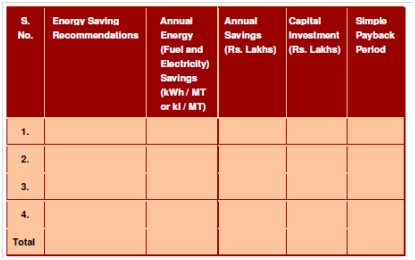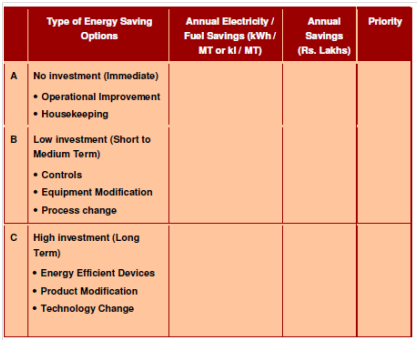Findings
This section is fundamentally descriptive in nature and should involved discussions on the plant performance which was observed.
Recommendations
Recommendations might be made in several areas such as the following:
- Energy utilization;
- Measures requiring further analysis;
- Separate project summary; and
- Action plan.
The table of contents of a classical energy audit report is shown below.
The worksheets given in Tables could be used as guidance for energy audit assessment and reporting.
Table: Summary of Energy Saving Recommendations

Table: Types and Priority of Energy Saving Measures

On the basis of the energy audit, certain actions can be recommended to decrease losses. We briefly outline them here.
Below given actions Recommended for Reducing Technical Losses
1. Reconfiguration;
2. Reconductoring;
3. Employing Shunt Capacitors;
4. Conversion from Single Circuit to Double Circuit;
5. Setting up of more Substations;
6. Changeover from Low Voltage Distribution System (LVDS) to High Voltage Distribution System (HVDS).
The following actions Recommended for Reducing Commercial Losses
1. Changeover to static meters along with tamper proof data and remote metering facility;
2. Replacing stuck up, all burnt, non-performing or underperforming meters;
3. Calibrating the existing meters;
4. Flying squads and Special task force for detection of pilferage of energy;
5. AMR for online energy recording.
The adoption of proper energy audit would ultimately facilitate increased revenue realization for the energy supplied to the consumers, identification of fields and causes of high energy losses and cutting down on its own expenses on account of the operational inefficiencies. It also helps the utility in bringing accountability and efficiency within its working. This would enable improving the financial health of the utility and would contribute substantially towards whole development of the power sector and improving financial health of the utilities. Let us now sum up what you have learnt here.